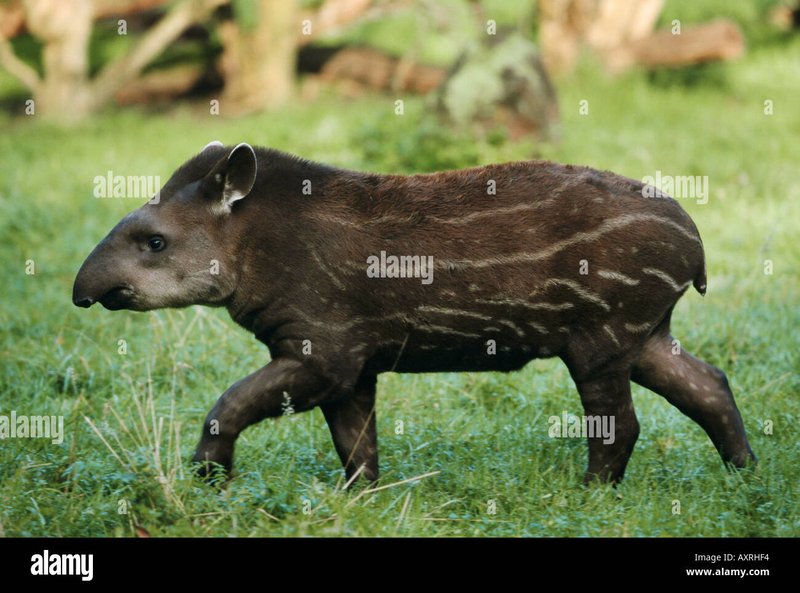
Imagine wandering through a lush, tropical forest. You stumble upon a gentle giant, munching on leaves and looking surprisingly graceful for its size. That’s a Brazilian tapir for you! These semi-aquatic mammals are native to South America and play a crucial role in their ecosystem. But just like us, they have their own ways of raising their little ones. So, let’s explore how Brazilian tapirs nurture their young in the wild, bringing a little piece of nature’s magic into our understanding.
Life Cycle of Brazilian Tapirs
Brazilian tapirs lead simple yet fascinating lives, and understanding their life cycle can help us appreciate their parenting. They typically reach sexual maturity between three and five years of age. Their mating season tends to vary depending on the availability of food and environmental conditions, but it generally peaks during the rainy season when food is abundant.
Once a female has mated, she carries her young for about 13 months—a long wait, similar to humans! This lengthy gestation period allows the baby tapir, or calf, to be born big enough to survive in the wild. Calves typically weigh around 20 to 25 pounds at birth and are born with a striking coat of stripes and spots. This unique pattern helps them blend into their surroundings, staying hidden from predators.
Throughout their lives, tapirs play an essential role in maintaining the balance of their ecosystem. Their foraging habits help disperse seeds, contributing to the growth of forests. This is just one more reason why understanding how they raise their young is so important; healthier tapirs mean healthier forests!
Mother’s Role in Upbringing
When calves are born, they rely entirely on their mothers for survival. The bond between a mother tapir and her calf is incredibly strong. Mothers provide not just food but also protection and guidance. The way they nurture their young is truly heartfelt.
Tapir mothers are very attentive. After giving birth, she keeps her calf close, often hiding it in dense foliage to keep it safe from predators. She only leaves them for short periods to feed. Here’s the thing: tapirs are naturally solitary animals, and this solitude extends to motherhood. Once the calf is around six months old, they become more independent, gradually learning how to forage and navigate their environment.
Interestingly, mothers often use vocalizations, low grunts, and whistles, to communicate with their young, helping establish a strong bond. This communication is crucial during the early stages of life when the calf is still learning to adapt to the wild.
Feeding and Nutrition
Feeding is a critical part of raising young tapirs. After being born, calves depend entirely on their mother’s milk for the first few months. Tapir milk is rich in nutrients, ensuring that calves grow strong and healthy. Typically, mothers will nurse their young for about six to eight months, allowing the little ones to build up their strength.
Once the calves start eating solid food, their diet expands. They begin to munch on leaves, fruits, and even bark. You might be wondering how they learn what’s safe to eat. Mothers often lead their calves to various feeding grounds, teaching them about the different types of plants, which ones are tasty, and which ones to avoid.
This stage can be exciting and a bit chaotic, as playful calves often try to grab bites before their mothers have a chance to share. Watching a mother tapir nudging her curious calf can be quite a sight!
Protection from Predators
In the wild, Brazilian tapirs face several predators. Young calves are especially vulnerable during their early months of life. Therefore, a mother tapir is always on high alert. She knows that their most significant threats include jaguars, caimans, and large snakes.
To protect their young, tapir mothers will create safe spaces, hiding their calves in thick vegetation while they forage nearby. This is a smart survival strategy, allowing their calves to remain safe while still getting the nourishment they need. If a predator does come too close, the mother tapir will be quick to react, kicking or charging at the threat to ward it off.
Interestingly, tapirs are known to swim well and often use water as a refuge. If things get dangerous, they won’t hesitate to dive into the nearest stream or river. A mother tapir knows that water can be a safe haven for her and her calf.
Social Learning and Exploration
As calves grow, they not only rely on their mothers for survival but also for social learning. Young tapirs observe their mothers closely, picking up skills and behaviors essential for life. This includes foraging techniques, communication cues, and how to stay safe.
Exploration is a huge part of growing up. You’ll often find calves following their mothers as they venture into new territories. Mothers encourage their young to explore while maintaining a watchful eye. This exploration is essential for their development, as young tapirs learn about their habitat, understand their environment, and become more independent.
It’s fascinating how this nurturing environment fosters confidence and curiosity. As they grow, these once-timid calves begin to embrace their surroundings, all thanks to their mother’s guidance.
Independence and Maturity
As calves reach about two years of age, they become more independent. By this time, they’ve learned a lot from their mothers. They know how to find food, recognize danger, and navigate their habitats.
However, this doesn’t mean they sever ties completely. Young tapirs will often stay close to their mothers for a while before fully venturing out on their own. This gradual transition gives them essential life skills while keeping them connected to their family unit, even if it’s less direct.
Mothers might still hang around during this phase to offer guidance, especially when it comes to navigating tricky situations, like finding the best feeding spots or evading predators. Eventually, young tapirs will leave their mothers to establish their own territories and start families of their own.
It’s a cycle that continues, keeping the Brazilian tapir population thriving and resilient.
The Importance of Conservation
Understanding how Brazilian tapirs raise their young shines a light on their importance in the ecosystem. Unfortunately, these magnificent creatures face threats from habitat loss and poaching. As their natural homes disappear, the challenges of raising young tapirs increase.
Conservation efforts are crucial in ensuring that tapirs can continue to thrive in the wild. They help preserve not just the tapirs themselves but also the health of their ecosystems. By protecting their habitats, we’re making sure that future generations of tapirs can grow, learn, and flourish just like those before them.
So, if you find yourself captivated by the nurturing ways of Brazilian tapirs, consider supporting conservation initiatives. Every little effort helps in safeguarding the future of these incredible animals and their young.
In summary, the process of how Brazilian tapirs raise their young is a beautiful blend of maternal care, instinct, and adaptation. From hiding their calves to teaching them essential survival skills, tapir mothers play a vital role in their children’s lives. By understanding this dynamic, we can better appreciate these enchanting creatures and the importance of their conservation in our world.

